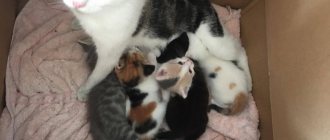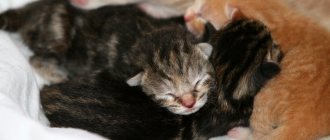Every responsible owner approaches the health of his furry pet with particular seriousness. Understanding that this factor is largely determined by several factors, the owner tries to create the most suitable conditions so that the development of kittens corresponds to all normal indicators. These include proper nutrition, the home conditions in which the animal lives, the presence of other pets in the house, and so on.
Why monitor the development of newborn kittens?
Knowing how a kitten grows and what skills it should acquire by a specific age, you can monitor your own pet. If you notice a deviation from the norm in any indicators in time, it is quite possible to eliminate it in the early stages of the problem.
The stages of growth and development of furry babies, from the moment of birth to one year, are associated with certain patterns. At the same time, each kitten is individual in its own way. Despite the fact that they go through the same stages of growing up, day by day and month by month. But they are all so different that it is impossible not to notice it even among the offspring of the same mother cat.
So, it should be noted that the first three months of a kitten’s life pass quite quickly for him. He is growing up quickly and gaining weight. This period is decisive in its further existence and development. Having overcome a kind of “critical” age threshold, most likely, everything will be fine in the future.
What should owners be wary of?
Care and attention are the most important things kittens need at this age. It is important not to miss the following points in the condition of a kitten up to 3 months:
- does not gain weight well;
- sleeps separately from the nursing cat and the rest of the litter of kittens;
- looks noticeably weaker than them;
- his mother ignores him;
- the kitten often experiences vomiting and diarrhea;
- discharge from the eyes, nose, anus.
If kittens have at least one of the above signs of pathology, they must be urgently shown to a specialist.
Cat pregnancy
At this time, you may want to find new homes for the kittens, but do not forget that kittens gain very valuable experience in the company of their mother and littermates. It is this period that plays a decisive role in whether they, already as adult cats, will be able to find a common language with their relatives.
The cat is in an interesting position, usually 9 weeks. But what incredible changes occur inside her (in utero) during this time.
Just imagine that in just 2.5 months, from a small zygote cell, you get a small but fully formed kitten, which will very soon begin an independent life.
To better understand what is happening in your cat’s body, we have compiled a handy list describing the changes by week:
- 1 – 2 weeks – In the first days after mating with a cat, it is very difficult to say whether they succeeded or not. During the first seven days, the male's sperm fertilizes the cat's eggs, and then they begin their movement to the uterus, where the kittens will develop in the future. The process of growth and development of kittens begins.
- 3 weeks – The embryo begins to develop organs. At this time, the cat experiences a real surge of hormones, its nipples darken and swell a little. In some cases, during this period the cat begins to develop toxicosis, suffers from nausea, and sometimes even refuses to eat. The size of the kitten during this period is only 25-30 mm. The formation of paws begins. The location of the kitten's ears and eyes has already been determined.
- 4 weeks - During this period, the genitourinary system of the future kitten is formed, the kidneys, bronchi and lungs, pancreas, esophagus, liver and thyroid gland are formed.
- 5 weeks – You can already visually observe a significant increase in the abdomen. At this time, experienced specialists can even determine the number of kittens that the female is bearing. After the 5th week, you need to be very careful when picking up your cat. During this period, the kitten’s nervous system begins its active construction.
- 6 weeks - Small kittens can already be identified in the cat’s stomach; the ribs, fingers, and wrists are saturated with calcium - now these are no longer cartilages, but bones. Teeth begin to form.
- From the 7th to the 9th week, kittens acquire an individual color and external individual characteristics of the breed begin to form.
In such a short period of time, a real miracle happens in the cat’s stomach.
The fact is that due to her large belly, she has poorer balance and there is a very high risk that she may fall or jump unsuccessfully. Take care of our little friends.
The first days after birth
There is probably no person who does not know that newborn kittens are absolutely defenseless. They are born tiny, like little mice, blind and deaf. The only thing they need in the first weeks is their mother. She is with them almost around the clock, leaving only occasionally to eat and relieve herself. Based on the first two weeks of kitten development, it is difficult to imagine what they will look like as adult animals. Their eyes are almost completely closed, and their tiny ears seem to be neatly folded.
It is worth noting that for a kitten in the first days it is extremely important that the cat be nearby. Thermoregulation in babies is imperfect; their bodies can quickly become hypothermic or, conversely, overheat. Mom helps maintain the optimal temperature in the place where their newly-made family is located.
On the 5th-6th day, the withered umbilical cord of the furry babies falls off. Eating, sleeping and periodically defecating are all they do in their young age. The cat tries to lick each kitten: thus, she cares for the offspring, maintaining hygiene and giving them regular abdominal massages, which helps stimulate sufficient excretion of feces and urine.
Features of the development of Scottish Folds
This cute breed lives on average about 15 years. Only by the second year of life does the pigmentation process in cats of this breed end.
It is believed that a kitten must be weaned from its mother no earlier than two months, while small kittens of other breeds can be weaned from their mother much earlier.
Active kittens of this breed react positively to scratching posts and brushing, which is a mandatory procedure for them. More often than other breeds, they encounter ear disease.
They have a beautiful color and thick fur. Expressive eyes and drooping ears make the face of this animal very cute.
Second week of life
At 10 days of age, babies' visual organs begin to open and their first hearing abilities appear. They already confidently respond to sound sources, the most significant of which for them can be called the meowing of a cat. Indeed, by 2 weeks, babies’ eyes are open, but their vision is still difficult to call clear: they see everything blurry and fuzzy.
The further development of kittens can be negatively affected by their separation from their mother at such an early age. In the first weeks after birth, for every baby, a cat is not only care, warmth and protection (including immune protection, with the help of antibodies that they receive in regular portions of colostrum and milk). Separation will also negatively affect the pet’s future relationships with people, other animals, and its learning abilities.
Feeding. Transition to solid foods
After three weeks, kittens should be weaned off their mother's milk by offering them solid food. Gradually introducing your babies to solid food will benefit both their health and the health of your cat. Receiving a small amount of food from your hands, the kittens will suckle their mother less and less each time. However, do not forget that the process should be gradual.
Buy canned or dry food for kittens, which you will first soak in water. Place a tiny piece of food on your finger and place it under your kitten's nose or lips.
For more information about what foods you can feed a small kitten, read our article: “What to feed a kitten? List of products by age.”
Kittens at three and four weeks of age
By the beginning of the third week, small fluffy balls usually begin to emit the first purr, the picture of the visual field of any kitten becomes definite: visually they will already be able to find their mother. After a week, the development of the organs of hearing and smell ends, and the ears take shape. In addition, kittens at the age of 3-4 weeks take their first hesitant steps and pay attention to their sisters and brothers. At the same time, their baby teeth appear, the incisors emerge first, followed by the canines, premolars and molars.
At 4 weeks, you don’t have to worry about the fact that it’s too early to introduce your young pet to the toilet. It is advisable to take care of the baby and, just in case, purchase a litter tray designed for kittens. They often perceive it either as food or as a toy. Ordinary contents of the litter tray may be harmful to the animal if swallowed (for example, silica gel).
Beginning of the second month of life
In the fifth week, the crumbs become simply unrecognizable. It seems that these “hooligans” have nothing in common with those motionless babies who were located in the nest about a month ago: they already run deftly, improve their sense of balance, can bypass obstacles, sneak up from behind and attack. By this time they are already showing concern for each other.
5 weeks is a turning point in the kitten’s nutritional system. At this age, you can try offering him complementary foods. The ideal supplementary diet (the main one is still cat milk) is canned food for kittens.
Peculiarities of behavior of kittens aged 1.5-2 months
After a couple of weeks, by the middle of the second month of life, they still bear little resemblance to adult lazy cats. Kittens constantly communicate, move actively, run, play, and sharpen their nails. A month and a half is a great time to get your first worm vaccination. If there are potentially dangerous objects in the house within easy reach of animals, it is better to remove them. This is about:
- all kinds of chemicals, detergents;
- first aid kit with medications;
- needles, pins, pushpins;
- electrical outlets;
- poisonous indoor plants, etc.
If the pet, at the request and insistence of the owner, is expected to engage in grooming in the future, then the basics of this area must be taught at 7-8 weeks. You should start with simple procedures, let the baby get used to bathing, combing fur, and cutting nails. Of course, by 2 months his claws have not yet become dangerous to others, like those of an adult animal, so there is no need to really trim them. It is important at an early age to accustom the kitten to the position in which this procedure will then take place.
At 8-9 weeks, all baby teeth are usually in place. With breastfeeding, many owners try to separate the babies and completely switch the kittens to “adult” food. Games and contact with people are especially important for small pets, so it would be better if all family members find at least 15-20 minutes every day to communicate with their pet.
Development of kittens by weeks and months
| First two weeks |
|
|
|
|
|
| Two to four weeks |
|
|
|
|
|
|
| Four to eight weeks |
|
|
|
|
| Eight to fourteen weeks |
|
|
|
|
|
| Six to twelve months |
|
|
In the first 12 weeks of their lives, kittens develop very quickly and need constant care. During this period, it is very important to monitor how the kitten gains weight. If the kitten is gaining weight slowly and the difference from the norm is significant, you should consult a veterinarian.
Other alarming signs that require contacting a veterinarian: the kitten is not eating well, sleeps away from other kittens and the mother, the mother does not take care of it, the kitten has vomiting, diarrhea, weakness, discharge from the nose, eyes, and anus.
Newborn kittens are completely defenseless and helpless: they are blind, deaf and need their mother almost around the clock. Their eyes are closed and their ears are curled.
READ How to care for Scottish kittens
Kittens cannot maintain their body temperature on their own and warm themselves near their mother. Therefore, in the first weeks it is very important to maintain a constant temperature in the nest so that the kittens do not become hypothermic or overheat.
The umbilical cord dries out and falls off within the first few days.
Kittens eat, sleep and defecate - these are all their activities during this period. The cat regularly licks her kittens. This way, it maintains hygiene, but not only: massage of the tummy and genitals stimulates the secretion of urine and feces.
During this period, kittens learn to respond to a sound source, their eyes gradually open - by the time they are two weeks old, they are usually open, but their vision is still blurry. Kittens begin to compete with each other for their favorite nipple (usually each kitten chooses its preferred nipple).
If at this age a kitten is separated from its mother and littermates, this can negatively affect its development and further socialization, impair learning abilities and lead to aggression towards people and animals, including other cats.
During this period, kittens are protected from diseases by the antibodies they receive in colostrum. This immunity usually lasts until the first vaccination.
By the third week, kittens have a well-developed sense of smell and can see well enough to find their mother. Babies can already purr.
By the fourth week, the sense of smell is fully formed, hearing is well developed, and loud, sharp sounds frighten the kitten. The ears begin to rise.
The babies begin to pay attention to their littermates and make their first attempts to walk. Their baby teeth are coming through. The incisors appear first, then the canines. The mother begins to leave the nest for short periods of time.
This week you can start introducing the kitten to the litter box. The kitten may start eating the litter - this happens quite often. Therefore, purchase a special litter for kittens that, if swallowed, will not cause much harm (for example, small wood pellets). The tray for a kitten should be smaller than for an adult.
By the fifth week, kittens' vision is fully formed, they develop a sense of balance, they learn to run, place their paws accurately, avoid obstacles, sneak up and attack. The babies begin to look after themselves and their littermates.
The kittens begin to explore the surrounding area. The fifth week is a great time for socialization and establishing contact with the kitten.
The kitten still feeds on mother's milk, but this week you can introduce complementary foods in the form of canned kitten food.
By the sixth or seventh week, kittens begin to sleep like adult cats, actively move and communicate with each other, and sharpen their claws.
To ensure the safety of the kitten, remove any dangerous objects, plants, chemicals from places accessible to it, and cover hard-to-reach places that the kitten can climb into.
At the sixth week, kittens usually undergo an initial deworming with a special kitten product.
Play is a very important way of learning for kittens. Social and object games develop coordination and social skills. Mostly babies learn by watching their mother. Kittens play both with each other and with objects.
They lie belly up, hug, chew and lick each other, attack from ambush, bury, throw up a toy, pull it with their paw, hold it in their mouths, catch its tail, and jump.
At the seventh week, kittens receive primary vaccination.
You can introduce your kitten to the basics of grooming: brushing, bathing and trimming nails. The baby does not need to cut his nails yet, but you can give him a training manicure: accustom the kitten to the position in which the claws are cut and touch his paws.
At the eighth week, all the kitten's teeth erupted.
At the ninth week, kittens completely switch from breastfeeding to ready-made food. This week, communication and play with humans becomes especially important for the kitten.
At the tenth week, the claws are ready for the first trim: they are already quite long and sharp. It's also time to give a second dewormer.
At the eleventh week, revaccination is carried out.
It is very important for the owner to understand and know what changes in kittens should occur with age.
If you notice that some indicators do not correspond to the norm, you can quickly influence the situation and show the little kittens to the veterinarian.
The sooner you pay attention to deviations, the greater the chances of helping the kitten grow up healthy.
1st week
Kittens are born completely defenseless, deaf and blind, and all they need is a mother whom they can smell. During the first few days, the cat should be nearby almost all the time, because thermoregulation in kittens is still imperfect and they can become hypothermic very quickly without their mother’s warmth.
After the fifth day of life, their umbilical cord dries out. The mother cat, in turn, must constantly lick her babies, thus giving them a tummy massage, which helps stimulate the intestines.
2nd week
At this age, kittens' eyes open, although their vision is still far from perfect - they still see everything in a blurry form. They begin to respond to sounds, trying to catch their mother's meow.
At this age, they receive the most important thing from a cat with milk - antibodies and form their immunity.
At such an early age, it is unacceptable to separate kittens from a cat, because in this case they will not be able to adapt normally to the outside world and establish coexistence with other animals and people.
3rd – 4th week
The time has come for the kitten to finally develop its visual fields and sharpen its hearing. They begin to make their first purr. Small ears take shape. By the end of the 4th week, baby teeth appear. The incisors are shown first and only then canines and molars are visualized.
The first month of the little meowing lump's life has passed. During this time, he grew noticeably and became wiser. But there is still so much interesting and new in this world for the little creature. Let us further consider the development of a cat month by month.
READ Prazitel for cats and kittens purpose dosage
Development in kittens after three months of life
After three months of age, it is difficult to notice radically noticeable changes in the development of furry babies. True, they grow intensively for up to six months. From 12 weeks to 6 months, they undergo natural preparation for independent living, acquiring fundamental skills and abilities through constant play.
During this period, a feature of the psychological development of almost sexually mature adult cats is the building of a hierarchy. The determination of the leader and subordinate members of their society, which includes people, is an essential component of the relationship between animals of a given species and other inhabitants of the house. It is not surprising that upon reaching 6 months of age, having grown stronger and gaining sufficient confidence in their own abilities, they test the limits of what is permitted, often challenging the owner.











